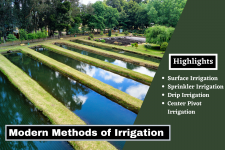dripwala
Farm Hand
- Messages
- 25
 Irrigation is defined as the carefully controlled process of watering agricultural crops through artificial means in order to facilitate their growth and development. Now you will see that we have mentioned the phrase ‘carefully controlled’ in the definition and are probably wondering what means.
Irrigation is defined as the carefully controlled process of watering agricultural crops through artificial means in order to facilitate their growth and development. Now you will see that we have mentioned the phrase ‘carefully controlled’ in the definition and are probably wondering what means. Well, the whole process of irrigation is strictly controlled. The farmer must determine the exact amount of water required by the crop. Too little water will dry out the plants, whereas too much water may damage the root. In addition to watering the crops, irrigation also entails watering the lands before planting seeds to create a favorable habitat for crops. It also needs to be done carefully. Thus, irrigation is a much more complicated process than just watering plants.
Modern Methods Of Irrigation
The methods of irrigation can be divided into four main types. These include – Surface irrigation, sprinkler, drip, and subsurface. These modern irrigation techniques have been discussed in detail below –- Surface irrigation –
It is one of the most common methods of irrigation. Here water is applied to the soil with the help of gravity. Since the distribution of water is not regulated, surface irrigation is also known as flood irrigation. This irrigation system is further classified as follows –
- Furrow – In the case of furrow irrigation, water is made to flow through shallow channels which are evenly spaced out and at a slope to the field. The water in these shallow channels is supplied through a variety of ways such as siphon, main ditch, gated pipe, etc.
2. Basin and border irrigation – Both of these techniques involve water running through the soil. However, in basin irrigation, water is supplied to a field which may result in ponding for a while. on the other hand, water is made to flow through ditches running through the ground with a drainage system at the end.
- Sprinkler Systems:
Water droplets are sprayed or sprinkled like raindrops over the landscape through rotating nozzles connected to pipelines. The pipelines are connected perpendicular to the main pipeline laid in the field.
- Useful for sandy soil and uneven land
- Protects plants/crops from extreme frost or temperature
- Fertilizer and insecticide can be applied through a sprinkler system
- Helps with soil conservation
- Drip System:
Water flows through narrow pipes laid on the fields and drips through small holes (emitters) directly at the place of plant roots. Roots absorb the water and nourish the plant. There is no water waste with this method, as less water is lost to evaporation, runoff, and wind.
- Optimizes soil moisture, saving water
- Direct hydration of plant roots for plant health
- Inhibits weed growth since water is applied directly to plants, not spread around the field
- Bacterial growth is limited since the area near plants is dry
- Center -Pivot Irrigation:
In center-pivot irrigation equipment is used which has many sprinklers aligned in an overhead line and the combination rotates around a pivot.- Center-pivot irrigation uses less labor than many other surface irrigation methods, such as furrow irrigation.
- It also has lower labor costs than ground-irrigation techniques that require digging of channels.
- Center-pivot irrigation can reduce the amount of soil tillage.
- Therefore, it helps reduce water runoff and soil erosion that can occur with ground irrigation
For detailed information visit: Home - Dripwala - A Practice Management App for Micro Irrigation

